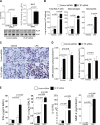Cathepsin G degradation of phospholipid transfer protein (PLTP) augments pulmonary inflammation
- PMID: 24532668
- PMCID: PMC3986847
- DOI: 10.1096/fj.13-246843
Cathepsin G degradation of phospholipid transfer protein (PLTP) augments pulmonary inflammation
Abstract
Phospholipid transfer protein (PLTP) regulates phospholipid transport in the circulation and is highly expressed within the lung epithelium, where it is secreted into the alveolar space. Since PLTP expression is increased in chronic obstructive pulmonary disease (COPD), this study aimed to determine how PLTP affects lung signaling and inflammation. Despite its increased expression, PLTP activity decreased by 80% in COPD bronchoalveolar lavage fluid (BALF) due to serine protease cleavage, primarily by cathepsin G. Likewise, PLTP BALF activity levels decreased by 20 and 40% in smoke-exposed mice and in the media of smoke-treated small airway epithelial (SAE) cells, respectively. To assess how PLTP affected inflammatory responses in a lung injury model, PLTP siRNA or recombinant protein was administered to the lungs of mice prior to LPS challenge. Silencing PLTP at baseline caused a 68% increase in inflammatory cell infiltration, a 120 and 340% increase in ERK and NF-κB activation, and increased MMP-9, IL1β, and IFN-γ levels after LPS treatment by 39, 140, and 190%, respectively. Conversely, PLTP protein administration countered these effects in this model. Thus, these findings establish a novel anti-inflammatory function of PLTP in the lung and suggest that proteolytic cleavage of PLTP by cathepsin G may enhance the injurious inflammatory responses that occur in COPD.
Keywords: lipopolysaccharide; lung; protease; signaling.
Figures







References
-
- Day J. R., Albers J. J., Lofton-Day C. E., Gilbert T. L., Ching A. F., Grant F. J., O'Hara P. J., Marcovina S. M., Adolphson J. L. (1994) Complete cDNA encoding human phospholipid transfer protein from human endothelial cells. J. Biol. Chem. 269, 9388–9391 - PubMed
-
- Oka T., Kujiraoka T., Ito M., Egashira T., Takahashi S., Nanjee M. N., Miller N. E., Metso J., Olkkonen V. M., Ehnholm C., Jauhiainen M., Hattori H. (2000) Distribution of phospholipid transfer protein in human plasma: presence of two forms of phospholipid transfer protein, one catalytically active and the other inactive. J. Lipid. Res. 41, 1651–1657 - PubMed
-
- Vuletic S., Jin L. W., Marcovina S. M., Peskind E. R., Moller T., Albers J. J. (2003) Widespread distribution of PLTP in human CNS: evidence for PLTP synthesis by glia and neurons, and increased levels in Alzheimer's disease. J. Lipid Res. 44, 1113–1123 - PubMed
-
- Desrumaux C., Risold P. Y., Schroeder H., Deckert V., Masson D., Athias A., Laplanche H., Le Guern N., Blache D., Jiang X. C., Tall A. R., Desor D., Lagrost L. (2005) Phospholipid transfer protein (PLTP) deficiency reduces brain vitamin E content and increases anxiety in mice. FASEB J. 19, 296–297 - PubMed
Publication types
MeSH terms
Substances
Grants and funding
LinkOut - more resources
Full Text Sources
Other Literature Sources
Medical
Molecular Biology Databases
Miscellaneous

